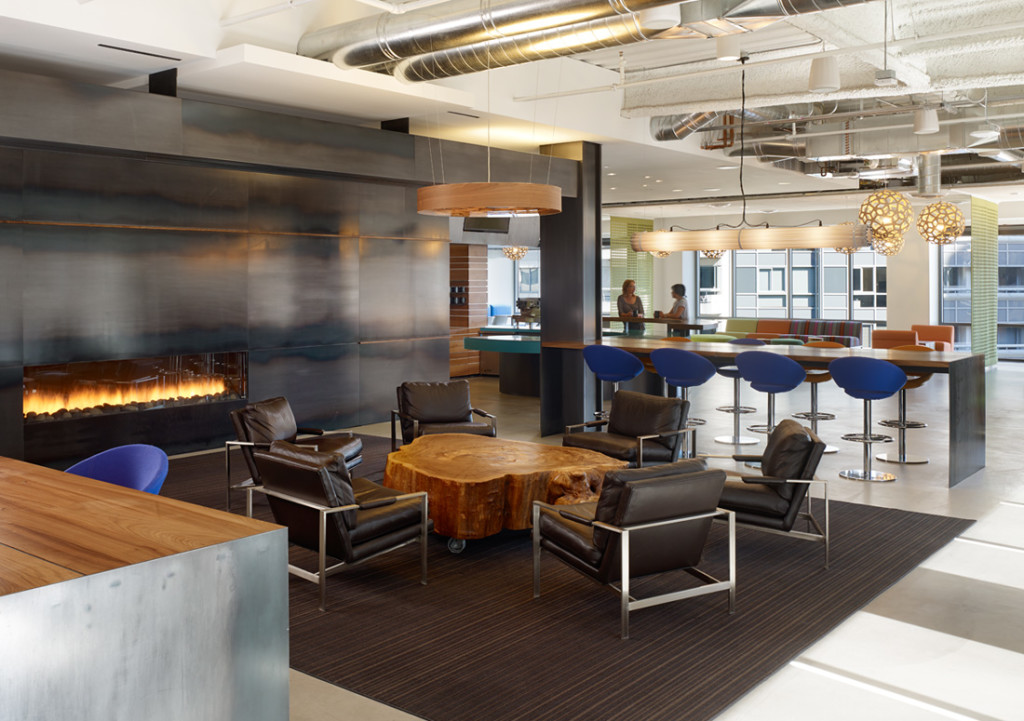BY LISA BROWN
Robin Weckesser, founder and president of a3 Workplace Strategies, discusses if employees are pining for their old cubicles and other workplace shifts in this GlobeSt.com office trends EXCLUSIVE.
New Relic’s headquarters, where a3 Workplace Strategies provided project management services.
Are employees pining for their old cubicles? And if we take a cue from home, the kitchen is the center of family gatherings, making it now number one on the list of company amenities. Robin Weckesser, founder and president of a3 Workplace Strategies, discussed this and other water cooler buzz in this GlobeSt.com office trends exclusive.
GlobeSt.com: What are the latest trends with open offices regarding benefits, pushbacks and workplace demographics? Are some employees pining for their old cubicles?
Robin Weckesser: The trend toward an open plan and higher density environment continues, and I don’t see that changing. Organizations are striving to accelerate their production cycle and seeking new ways to approach innovation. The trend toward an open plan and higher density environment is a response to this challenge while it also offsets high rents. Cost savings generated from a reduced floor area requirement equates to a reduction in rent expense. Combined with more collaborative work settings, alternative/creative workplaces also help in the recruitment of top talent.
I think the use of alternative spaces is dependent on the task contained within the space and the culture of the organization. Staffs that have been in private offices or large, high-wall workstations have the hardest time with the transition and need the most help.
In my opinion, most employees aren’t necessarily pining for old cubicles; they are pining for fewer distractions. If there’s chaos, commotion and distraction, it follows that it will lead to frustration. Employees may say that their task requires periods of concentration and they need a space to that accommodates that. That’s why the role of the architect and project manager is critical in understanding the cultural communication patterns and work functions.
GlobeSt.com: How can change management lead to smooth workplace transformation?
Weckesser: A thoughtfully designed and implemented change management process is key to a successful transition to a new work setting. If we think of the workplace as a tool that facilitates a process, think of change management as the owner’s manual for that tool. It’s a marketing communication process that will generate excitement around the move to a new workplace. If staff are engaged at the start of the design process and see that alternative settings will support their work, that is the first step in a smooth transition.
Change management should inform employees of every step. They want to know what’s going on and why … and to learn how the end result will benefit them and the organization. Certainly, workplace change will affect them and at some level, they may feel a loss of control. Ongoing information about the project, the next steps, what to expect and when to expect it will help them become more comfortable with the change, mitigating a sense of anger, opposition and reluctance in favor of acceptance, anticipation and support.
In planning to roll out a change management program, it’s important to be sensitive to the needs of the entire workforce, including older managers who might feel a sense of entitlement. Ultimately, it’s about development of task-appropriate work settings.
GlobeSt.com: What office amenities are most desired and what is the latest with the life-work-play dynamic?
Weckesser: While food has been considered an important amenity for a long time, I think it is now number one on the list! Companies at all levels are looking to provide the highest quality dining programs they can afford. Hands down, cafeterias and cafes have become the best points for gathering and collaborative interaction.
If we take a cue from home, the kitchen is the center of family gatherings. Our families come together there mornings, afternoons and evenings. In the workplace, these spaces potentially can have the same role—and it’s a critically important role in a space that nourishes, refreshes, energizes and invigorates.
Other important amenities and lures for new talent include fitness centers and environmental accommodations like natural light and other green factors.
GlobeSt.com: In designing workplaces of the future, what is the importance of branding and corporate culture?
Weckesser: I think physical space should be viewed as a backdrop for brand reinforcement and a vehicle for communicating the brand, mission and culture to staff and customers. It’s a backdrop for telling the corporate story internally and externally. Much like the family photo wall at home, it reinforces the culture, tells the story of the customer base and enhances the brand.
GlobeSt.com: What future trends can we anticipate with younger workers, technology and mobility?
Weckesser: Having grown up with technology, millennials and Generation Z workers use it fearlessly and with amazing skill. I think younger workers will continue to push the boundaries of the use of technology and will force IT organizations to provide bandwidth in every corner of the work space along with the tools employees need to work anywhere, anytime.
Technology and mobility are linked. That said, connection with others is a basic human need. We need interaction. We crave socialization. So the need for a space to connect, meet, bring the pack together, to brainstorm, eat, talk, interact and create will never go away. The corporate home should be an inviting place to enter at any time.


